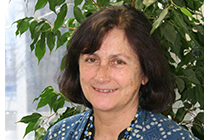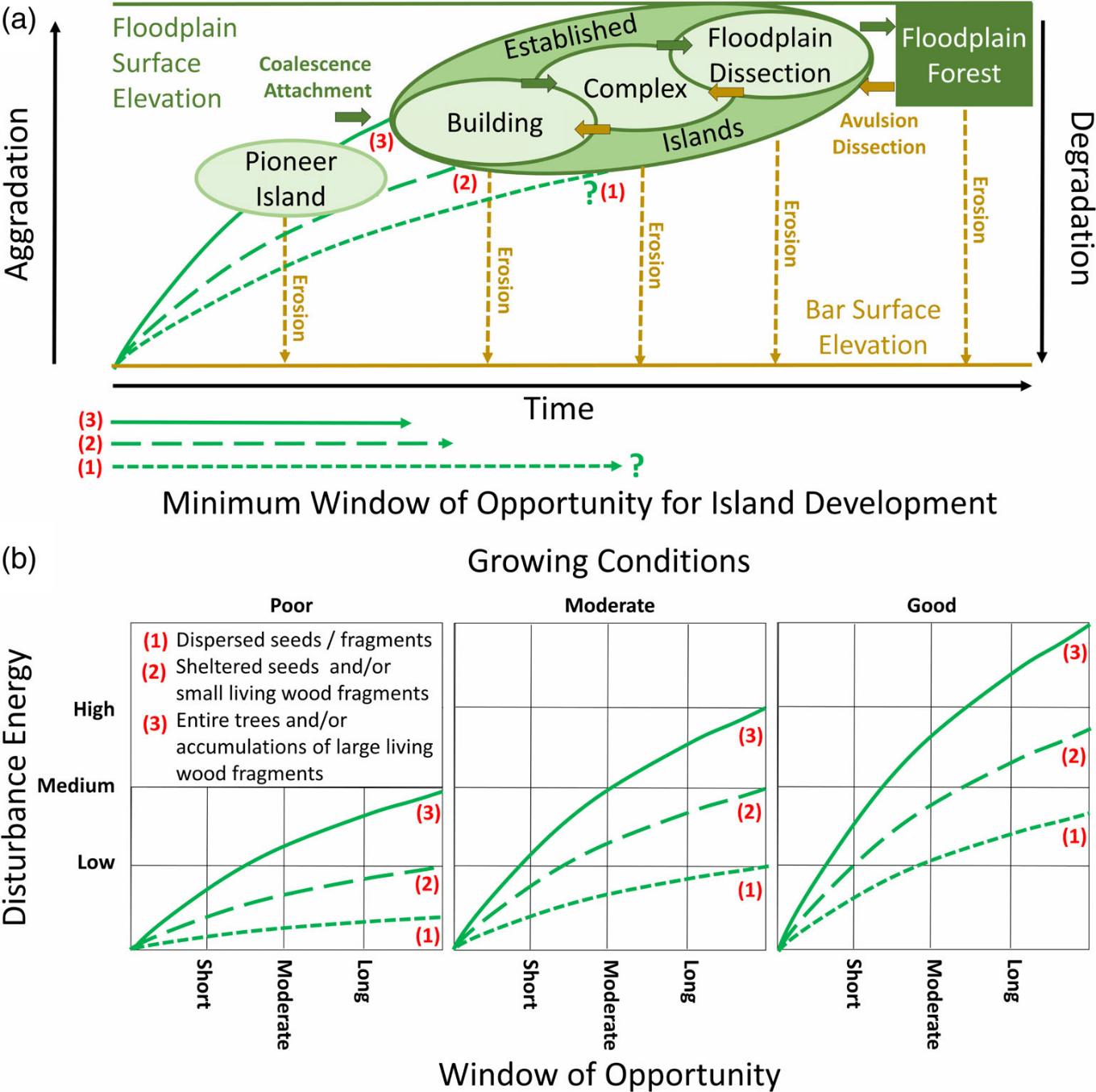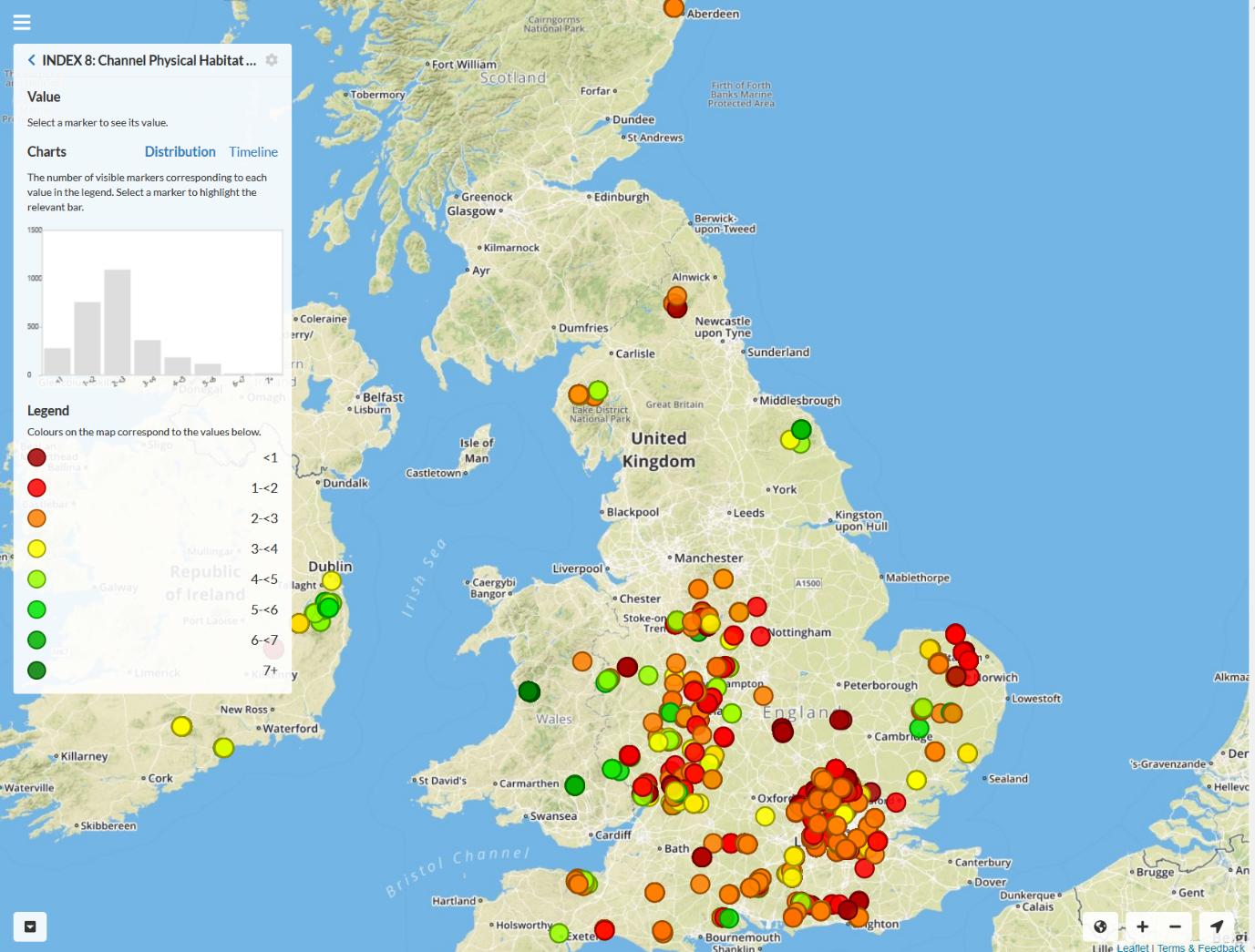-
Gurnell, A.M., Bertoldi, W. 2020. Extending the conceptual model of river island development to different environmental conditions and tree species. River Research and Applications, 36(7): 1183-1201.
-
Bertoldi, W., Gurnell, A.M. 2020. Physical engineering of an island-braided river by two riparian tree species: evidence from aerial images and airborne lidar. River Research and Applications, 36(7): 1183-1201.
-
Gurnell, A.M., Scott, S.J., England, J., Gurnell, D.J., Jeffries, R., Shuker, L., Wharton, G. 2020. Assessing river condition: A multiscale approach designed for operational application in the context of biodiversity net gain. River Research and Applications, 36(8): 1559-1578.
-
Gurnell, A.M., Bertoldi, W. 2020. Wood in fluvial systems. In: Shroder, J., Jr. (Editor in Chief), Wohl, E. (Ed.), Treatise on Geomorphology. Academic Press, San Diego, CA, doi: 10.1016/B978-0-12-409548-9.12415-7
-
Shumilova O., Tockner K., Gurnell A.M., Langhans S.D., Righetti M., Lucía A., Zarfl C. 2019. Floating matter: A neglected component of the ecological integrity of rivers. Aquatic Sciences 81, doi:10.1007/s00027-019-0619-2
-
Wohl, E., Comiti, F., Fausch, K., Gurnell, A.M., Jaeger, K., Kramer, N., Lininger, K., Piégay, H., Ruiz-Villanueva, V., Scott, D., Stout, J., Walters, D. 2019. The natural wood regime in rivers. BioScience, 69, 259-273, doi:10.1093/biosci/biz013
-
Gurnell, A.M., England, J., Shuker, L., Wharton, G., 2019. The contribution of volunteers to river monitoring: international and national perspectives and the example of the MoRPh survey. River Research and Applications, 35(8), 1359-1373.
-
Gurnell, A.M., Foster, I.D.L., Gregory, K.J., Wood, P., 2019. Professor Geoffrey Petts (1953-2018): An outstanding interdisciplinary river scientist. River Research and Applications, 35(8), 1075-1090.
-
Henshaw, A.J., Sekarsari, P., Zolezzi, G., Gurnell, A.M., 2019. Google Earth as a data source for investigating river forms and processes: Discriminating river types using form-based process indicators. Earth Surface Processes and Landforms, 45(2), 331-344.
-
Politti, E., Bertoldi, W., Gurnell, A.M., Henshaw, A., 2018. Feedbacks between the riparian Salicaceae and hydrogeomorphic processes: a quantitative review. Earth Science Reviews, 176, 147-165.
-
Serlet, A.J., Gurnell, A.M., Zolezzi, G., Wharton, G., Belleudy, P., Jourdan, C. 2018. Biomorphodynamics of alternate bars in a channelized, regulated river: insights from an analysis of historical records. Earth Surface Processes and Landforms, 43, 1739–1756, doi: 10.1002/esp.4349.
-
Gurnell, A.M., Holloway, J.V., Liffen, T., Serlet, A.J., Zolezzi, G. 2018. Plant root and rhizome strength: Differences among species within river margins. Earth Surface Processes and Landforms. doi:10.1002/esp.4499
-
Gurnell, A.M., Bertoldi, W., Francis, R.A., Gurnell, J., Mardhiah, U. 2018. Understanding processes of island development on an island braided river over timescales from days to decades. Earth Surface Processes and Landforms. 44(2): 624-640. Doi: 10.1002/esp.4494
-
Gurnell, A.M. 2018. Twenty-five years of progress in physical geography: a personal view of its antecedents and trajectory. Geography 103, 122-136.
-
Wilkes, M., Gittins, J., Mathers, K., Mason, R., Casas-Mulet, R., Vanzo, D., Mckenzie, M., Murray-Bligh, J., England, J., Gurnell, A.M., Jones, J.I. 2018. Physical and biological controls on fine sediment transport and storage in rivers. WIRES Water, 21 pages, doi: 10.1002/wat2.1331
-
Holloway, J.V., Rillig, M.C., Gurnell, A.M. 2017. Underground Riparian Wood: Buried Stem and Coarse Root Structures of Black Poplar (Populus nigra L.). Geomorphology 279, 188-198. DOI: 10.1016/j.geomorph.2016.08.002
-
Holloway, J.V., Rillig, M.C., Gurnell, A.M. 2017. Underground Riparian Wood: Reconstructing the Processes Influencing Buried Stem and Coarse Root Structures of Black Poplar (Populus nigra L.). Geomorphology 279, 199-208. DOI: 10.1016/j.geomorph.2016.07.027
-
Belletti, B., Rinaldi, M., Bussettini, M., Comiti, F., Gurnell, A.M., Mao, L., Nardi, L., Vezza, P. 2017. Characterising physical habitats and fluvial hydromorphology: a new system for the survey and classification of river geomorphic units. Geomorphology 283, 143-157.
-
Holloway, J.V., Rillig, M.C., Gurnell, A.M. 2017. Physical Environmental Controls on Riparian Root Profiles associated with Black Poplar (Populus Nigra L.) along the Tagliamento River, Italy. Earth Surface Processes and Landforms. DOI: 10.1002/esp.4076
-
Zen, S., Gurnell, A.M., Zolezzi, G., Surian, N. 2017. Exploring the role of trees in the evolution of meander bends: the Tagliamento River, Italy. Water Resources Research, 53, doi:10.1002/2017WR020561.
-
Gurnell, A.M., Corenblit, D., García de Jalón, D., González del Tánago, M., Grabowski, R.C., O’Hare, M.T. and Szewczyk, M., 2016. A conceptual model of vegetation-hydrogeomorphology interactions within river corridors. River Research and Applications, 39, 142-163, DOI: 10.1002/rra.2928.
-
Gurnell, A.M. and Grabowski, R.C., 2016. Vegetation-hydrogeomorphology interactions in a low-energy, human-impacted river. River Research and Applications, 39, 202-215, DOI: 10.1002/rra.2922.
-
Gurnell, A.M., Rinaldi, M., Belletti, B., Bizzi, S., Blamauer, B., Braca, G., Buijse, T., Bussettini, M., Camenen, B., Comiti, F., Demarchi, L., García de Jalón, D., González del Tánago, M., Grabowski, R.C., Gunn, I.D.M., Habersack, H., Hendriks, D., Henshaw, A.J., Klösch, M., Lastoria, B., Latapie, A., Marcinkowski, P., Martínez-Fernández, V., Mosselman, E., Mountford, J.O., Nardi, L., Okruszko, T., O’Hare, M.T., Palma, M., Percopo, C., Surian, N., van de Bund, W., Weissteiner, C. and Ziliani, L., 2016. A multi-scale hierarchical framework for developing understanding of river behaviour to support river management. Aquatic Sciences, 78: 1-16. DOI 10.1007/s00027-015-0424-5.
-
Grabowski, R.C. and Gurnell, A.M., 2016. Diagnosing problems of fine sediment delivery and transfer in a lowland catchment. Aquatic Sciences, 78: 95-106. DOI 10.1007/s00027-015-0426-3.
-
Rinaldi, M., Gurnell, A.M., González del Tánago, M., Bussettini, M., Hendriks, D. 2016. Classification of river morphology and hydrology to support management and restoration. Aquatic Sciences, 78: 17-33. DOI 10.1007/s00027-015-0438-z
-
González del Tánago, M., Gurnell, A.M., Belletti, B. 2016. Indicators of river system hydromorphological character and dynamics: understanding current conditions and guiding sustainable river management. Aquatic Sciences, 78: 35-55. DOI 10.1007/s00027-015-0429-0
-
Gurnell, A.M., Bertoldi, W., Tockner, K., Wharton, G., Zolezzi, G. 2016. How large is a river? Conceptualising river landscape signatures and envelopes in four dimensions. WIREs Water 2016. doi: 10.1002/wat2.1143
-
Zen, S., Zolezzi, G., Toffolon, M., Gurnell, A.M. 2016. Biomorphodynamic modelling of river-floodplain interactions in migrating meander bends. Advances in Water Resources Research 93: 166-181. DOI: 10.1016/j.advwatres.2015.11.017 0309-1708/.
-
Corenblit, D., Steiger, J., Charrier, G., Darrozes, J., Garófano-Gómez, V., Garreau, A., González, E., Gurnell, A.M., Hortobágyi, B., Julien, F., Lambs, L., Larrue, S., Otto, T., Roussel, E., Vautier, F., Voldoire, O. 2016. Populus nigra L. establishment and fluvial landform construction: biogeomorphic dynamics within a channelized river. Earth Surface Processes and Landforms 41(9): 1276-1292.
-
Ruiz-Villanueva, V., Piégay, H., Gurnell, A., Marston, R., Stoffel, M. 2016. Recent advances quantifying the large wood cycle and dynamics in river basins: new methods, remaining challenges. Reviews of Geophysics. 54, 611–652, doi:10.1002/2015RG000514
-
Gurnell, A.M. 2016. Trees, wood and river morphodynamics: results from 15 years research on the Tagliamento river, Italy. In Gilvear, D.J., Greenwood, M.T., Thoms, M.C., Wood, P.J. (eds) River Science: Research and Applications for the 21st Century, 132-155, John Wiley and Sons Ltd., Chichester, UK, DOI: 10.1002/9781118643525.
-
Grabowski, R.C., Gurnell, A.M. 2016. Using historical data in fluvial geomorphology. In: Kondolf, G.M., Piégay, H. (eds.) Tools in Fluvial Geomorphology, Wiley, Chichester, 56-75.
-
Osei, N.A., Gurnell, A.M., Harvey, G.L. 2015. The role of large wood in retaining fine sediment, organic matter and plant propagules in a small, single-thread forest river. Geomorphology 235, 767-87.
-
Garcia Lugo, A.G., Bertoldi, W., Henshaw, A.J., Gurnell, A.M. (2015) The effect of lateral confinement on gravel bed river morphology. Water Resources Research, 51, 7145-7158, DOI: 10.1002/2015WR017081.
-
Bertoldi, W., Welber, M., Gurnell, A.M., Mao, L., Comiti, F., Tal, M. 2015. Physical modelling of the combined effect of vegetation and wood on river morphology, Geomorphology, 246: 178-187, doi: 10.1016/j.geomorph.2015.05.038.
-
Corenblit, D., Baas, A., Balke, T., Bouma, T., Fromard, F., Garófano-Gómez, V., González, E., Gurnell, A.M., Hortobágyi, B., Julien, F., Kim, D., Lambs, L., Stallins, A., Steiger, J., Tabacchi, E. and Walcker, R., 2015. Engineer pioneer plants respond to and affect geomorphic constraints similarly along water–terrestrial interfaces world-wide. Global Ecology and Biogeography, 24(12), 1363-137, doi: 10.1111/geb.12373.
-
Corenblit, D., Steiger, J., Charrier, G., Darrozes, J., Dousseau, J., González, E., Gurnell, A.M., Julien, F., Lambs, L., Larrue, S., Roussel, E., VautierF., Voldoire, O. (2014) The biogeomorphological life cycle of poplars during the fluvial biogeomorphological succession: a special focus on Populus nigra L. Earth Surface Processes and Landforms, 39(4) 546-563.
-
Cockel, C., Gurnell, A.M., Gurnell, J. (2014) Management of an invasive plant species: physical manipulation experiments on Impatiens glandulifera along urban river banks. River Research and Application, 30, 217-229
-
Gurnell, A.M. (2014) Plants as river system engineers. Earth Surface Processes and Landforms, 39, 4-25.
-
Mardhiah U, Caruso T, Gurnell A, Rillig MC. 2014. Just a matter of time: fungi and roots significantly and rapidly aggregate soil over four decades along the Tagliamento River, NE Italy. Soil Biology & Biochemistry 75: 133-142.
-
Grabowski RC, Surian N, Gurnell AM. 2014. Characterizing geomorphological change to support sustainable river restoration and management. WIREs Water 2014, doi: 10.1002/wat2.1037.
-
Mardhiah U, Rillig MC, Gurnell AM. 2014. Reconstructing the development of sampled sites on fluvial island surfaces of the Tagliamento River, Italy, from historical sources. Earth Surface Processes and Landforms, doi: 10.1002/esp.3658.
-
Gibbs HM, Gurnell AM, Heppell CM, Spencer KL. 2014. The role of vegetation in the retention of fine sediment and associated metal contaminants in London's rivers. Earth Surface Processes and Landforms 39(8): 1115-1127.


